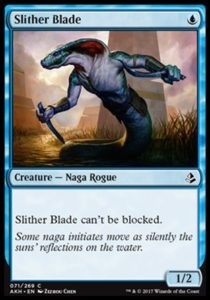So, those who watched the Pro Tour this past weekend probably learned a secret about Amonkhet draft (which some of us might have also been privy to): aggro is good. Like, absurdly good. And this isn’t your run-of-the-mill aggro, where you curve out 2, 3, 4, 5 and maybe shave a land down to sixteen. We’re talking infinite one-drop aggro with as low as fourteen lands.
How can this be? Amonkhet didn’t look to be the next Zendikar or Gatecrash, where 2/1s for two were solid playables and 3/3s for two existed. Both of those formats also rewarded you for playing 17+ lands, given landfall and multicolor being powerful incentives. Well, we’ve got the answers, and some are more obvious than others.
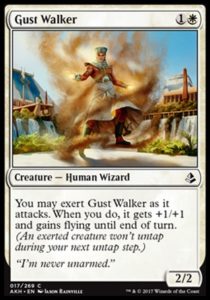
Exert
Exert is one of the most powerful aggressive mechanics we’ve ever seen. Exalted, Raid, and Battalion all rewarded aggression, but those cards tended to work best as part of wide army—Exalted let you get in a big swing with one creature, Raid gave you a one-time benefit, and Battalion rewarded you for having a large board presence.
Exert requires so much less work. Sure, creatures with exert get better together (they work best when they all exert at the same time), but they’re all very good on their own. Exert is a mechanic which allows normally reasonable creatures to dramatically power up when they need to for no cost. If a 2/2 for two is good, then you’ve got Gust Walker. If a 2/2 for two is bad, it’s basically a wasted card, but becoming a 3/3 flying and phasing out for a turn when a 2/2 doesn’t cut it makes Gust Walker absurdly flexible. Every creature with Exert is a double-faced card that you can transform almost at will—one side a reasonable creature, the other side an insane creature. It only function on offense, so it strongly rewards aggression. It should come as no surprise that a format with Exert presses players to be as fast as possible.
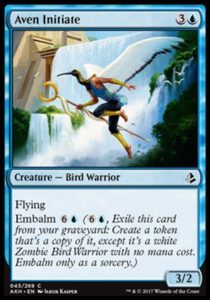
Slower competing mechanics
Aggression and Exert are made stronger by the other set mechanics in Amonkhet.
Embalm creatures are a bit overcosted for their initial stats, since they reward you for all being two-for-ones. However, if a game is decided by turn five or six, then players don’t have time to start embalming their creatures. Suddenly, Embalm means nothing other than that a creature is overcosted, and grossly so considering the potential stats of Exert creatures.
Aftermath is the same story as Emblam—you’re getting card advantage, but at the cost of overcosted effects and a hefty mana investment.
Cycling allows players use of their mana on every turn. In theory, this should make slower decks better, since they’re more consistent and have constant use for their mana. However, in allowing people to use their mana at all times, Cycling tricks people into spending mana without building a board presence. Cycling a card doesn’t do anything (unless you’ve got something like a Ruthless Sniper or Shefet Monitor). Cycling cards also suffer from the same problem as Embalm cards: they’re just a bit more expensive for their effect, making them that much slower against aggro.
Embalm, Aftermath, and Cycling all encourages players to be a little slower, a little bit more card advantage-focused, and a lot weaker to aggressive strategies.
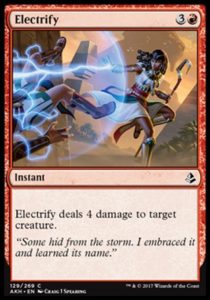
Shockingly weak removal
In a normal format, Electrify and Final Reward are highly efficient removal spells, able to kill almost any creature in the format at a reasonable cost and instant speed. Amonkhet is not a normal format. Electrify trades terribly on mana against most Exert creatures (many of which are kill-on-sight) and is similarly poor against Embalm creatures. Final Reward is almost always going to trade down on mana—it’s great at killing bombs like Glorybringer and Archfiend of Ifnir, but abysmal at killing Nef-Crop Entagler, the latter of which are going to be killing you far more often.
Magma Spray and Compulsory Rest are among the best removal spells in the format specifically because they effectively answer two drops. They’re also in white and red, two of the strongest aggressive colors, and slot perfectly into the aggressive decks. This serves to further strengthen the aggressive decks, rather than hamper them.
Aggro begets aggro
In Constructed, when aggro is good, one is often rewarded for being just a little slower and bigger. Your three and four drops stonewall your opponent’s faster curve and you beat them on raw power. In Limited, this is also often correct. However, Exert allows creatures to cheat on mana—a 3/2 trample for two, a 5/4 for three, and a 5/4 menace for four all so ridiculously undercosted and difficult to block that’s there no point in trying. Moreover, you can’t use these stats to block, since Exert only buffs attacking creatures.
When you’re unable to block profitably, the other option is to attack more, which involves playing one drops. Slither Blade lets you start getting in damage a turn earlier, which adds up to an extra four damage by turn five. Honed Khopesh gives you a one drop and lets you beef your creatures up. Cartouche of Zeal lets you gain tempo and essentially a turn on our opponent. These cheap cards are the best counterattack to a powerful offense, and since they’re the only counter to aggro, the entire format tilts to be faster and more aggressive in order to counter the faster and more aggressive decks.
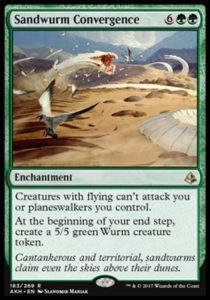
A new equilibrium
Eventually, Amonkhet will settle into a new balance where slower decks will become consistently viable once again. They’ll be viable not because they’re able to effectively and consistently beat aggro on their own, but because aggro will be overdrafted to the point that it will beat itself. This is reminiscent of what happened with the Spider Spawning deck, which was nigh-unstoppable when it came together, but easy to snipe cards from or overdraft. It will take time for people to learn the intricacies of Amonkhet aggro (’cause seriously, Slither Blade looks just as unplayable as Triton Shorestalker), but when they do, mark my words, we’ll see more top-performing green decks (which are predisposed to be slower than the other four colors, given that it has no one drops and less aggressive two drops than the rest).
And that’s why Amonkhet Limited is so aggressive. I hope you’ve been enjoying this sweet, bizarre format as much as I have. It’s a blast, a paradoxical format where it can be correct to play anywhere between fourteen and eighteen lands. I look forward to seeing how it evolves between now and Grand Prix Las Vegas and Cleveland (both of which I hope to attend). But until then, and as always, thanks for reading.
Oh, and a tiny plug! If you’re around New York City this week, stop by the NYU Game Center End of Year Show! I’m graduating from game design school and showing off my team’s master’s thesis, Lightrunners on real arcade cabinets!
—Zachary Barash
Zachary Barash is a New York City-based game designer. He learned Magic in 1994 and is still afraid of Living Wall (don’t click it! It’ll see you!). He’s two weeks away (!!!!) from receiving MFA in Game Design at NYU. After that, it’s back to designing for Kingdom Death: Monster.
His favorite card of the month is Hieroglyphic Illumination. It combines two underwhelming cards into something far greater than the sum of its parts, and that’s before considering all of the cycling and spells-matter shenanigans in Amonkhet.


